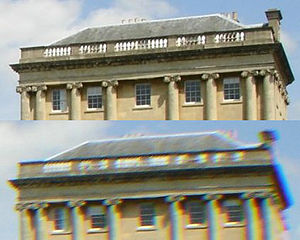Chromatic aberration
Chromatic Aberration is an optical aberration that occurs when light passes through a medium such as a glass lens which causes different wavelengths (colors) of light to focus at different focal lengths and degrades the image.
this page is a work in progress
Refraction
Refraction is the bending of light by passing it through a medium. While the speed of light in a vacuum is approximately 300,000 kilometers per second, when light passes through a medium such as air, water, or glass, it is slowed. Different wavelengths of light, which are perceived by human eyes as colors, are affected to differing amounts. Light with shorter wavelengths, which appears bluer, is bent to a greater degree than is light with a longer, redder, wavelength.

The same phenomenon is what makes a prism split white light into separate colors also causes chromatic aberration. In the example image to the right, as white light passes through the glass prism, the various colors of light are slowed at varying rates, causing them to bend, or refract.
In a typical glass convex lens, the glass is thicker in the center and thinner along the edges of the lens. When light passes through the glass, it is slowed down. Because there is less glass on the edges, that light is slowed less than the light closer to the center. This causes the path of all wavelengths of light to bent toward the center axis of the lens. Where the light rays all converge is the focal point.
But because red light is less affected than blue light, the focal point for red light will be further from the lens than it will be for blue light.
asdfasdf
ABCPDQ
References
- ↑ Image by By Lucas V. Barbosa - Own work, Public Domain, WikiMedia Commons

